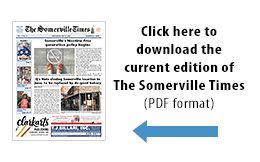(The opinions and views expressed in the commentaries and letters to the Editor of The Somerville Times belong solely to the authors and do not reflect the views or opinions of The Somerville Times, its staff or publishers.)
By Matt Harutunian, Edith Mooers, and Tara Ten Eyck
Dear Editor,
The MIT RNAV Study has reached a point at which the communities impacted by the 2013 implementation of the 33L RNAV Standard Instrument Departure (SID) procedure are being asked to provide feedback to Massport about which proposed dispersion concepts are most desirable – and equitable – to our cities.
As background on this issue, the MIT RNAV Study provides a detailed analysis of flight path changes (from Logan’s Runway 33L) resulting from FAA’s aRea NAVigation (RNAV) procedures that went into effect in 2013. RNAV replaced radar-based navigation with GPS-based routing, which results in more concentrated flight paths. The MIT Study also proposes some dispersion options for communities to consider.
We have been living under one of these concentrated RNAV paths for the past six years when flights were shifted over West Somerville. In 2013, before the new procedures were implemented, there were fewer and less frequent 33L flights flying directly over our neighborhood; fast forward to 2019, and there could be 300 flights on a peak day, spaced a minute and a half apart for hours on end.
These planes are flying over our neighborhood late in the evening and early in the morning and follow the same path over and over again. They interrupt our sleep, detract our ability to do yardwork, and negatively impact our quality of life.
Prior to these new policies going into effect, they were disbursed over a much larger part of Somerville. The attached slides depict how that shifting in concentration has unfairly and inequitably placed all of the burden of the growing number of departures from Runway 33L over our neighborhood.
Several of the concepts proposed by MIT have the potential to decrease the concentration over West Somerville. In order for any of these dispersion concepts to achieve a more equitable and fair sharing of the burden, some of the neighborhoods that got relief from flights in 2013 need to take some of them back. 59% of residents in our city received SOME dispersed airplane noise pre-RNAV in 2013, while 14% now receive ALL concentrated airplane noise post-RNAV. In 2012, there were 95 airplane noise complaints registered in Somerville; in 2018, that figure was 2,565 – a 250-fold increase!
That’s just not fair.
We realize that the selection of one or more of these dispersion concepts to recommend to Massport for consideration by the FAA will require cooperation from residents of all the impacted communities of 33L. We request that our local officials, state legislators, and the Massport Community Advisory Committee (CAC) continue to conduct an open, transparent, and public process.
We are thankful to Mayor Curtatone and the City Council for organizing a public hearing on this issue on Wednesday, September 18 at 6 pm at City Hall. We look forward to the discussion and working with all parties towards a solution that more fairly and equitably shares the flight noise burden across our neighborhoods.
Matt, Edith, and Tara are voters and residents in Somerville.
















Thank you for writing this.